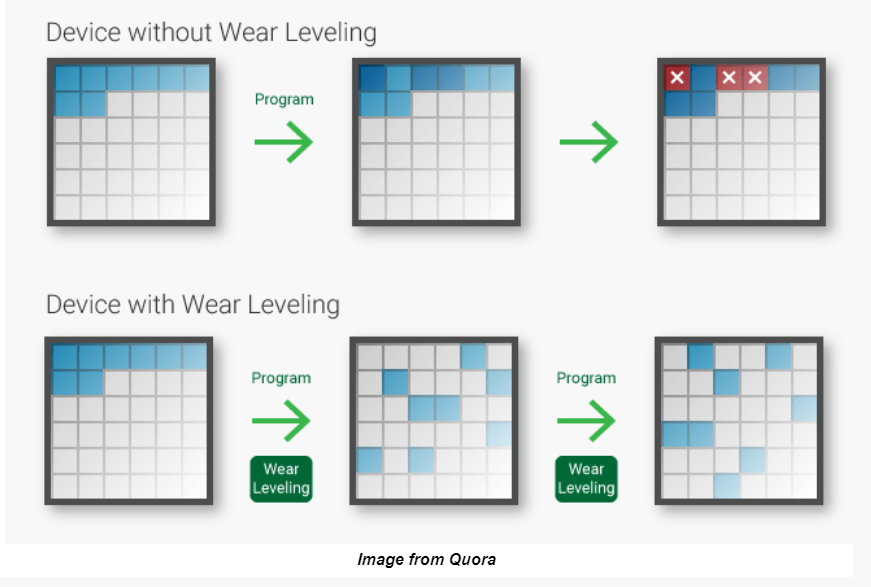
Wear leveling is a means to prolong the lifespan of a range of erasable storage devices which utilise flash memory.
These devices include USB flash drives, solid state drives, tablets, computers and many other similar devices. Wear leveling is designed to reduce the number of overwrite cycles the device has to make by evenly spreading the burden on memory blocks across the device rather than relying on a select few.
In this blog, we’ll be looking into exactly what wear leveling is, what it’s for and why wear leveling is important.
Wear Leveling: Explained
Wear leveling is a process that is programmed into devices using flash memory to ensure that each of the blocks of memory within the device are being used as efficiently as they possibly can be.
This process is crucial for enhancing both capacity and longevity of the memory writing abilities. If a flash device didn’t take advantage of wear leveling algorithms, data would be written to an entire block of the memory device, which may not be efficient for the memory of the device.
In other words, without this process, the entire blocks of memory on your flash device would be prematurely filled. This is opposed to using the most efficient blocks open to keep space available for more files to be added to the device, while reducing overuse of blocks which have seen more overwrites.
Wear leveling prevents non-sequential writing errors too, which ensures that each block is used efficiently before the next one is used.
How Do Wear Leveling Algorithms Work?
The wear leveling algorithm works by having the controller component make something known as an ‘erase count’ within each block, to instruct new data to be written to a block with the lowest erase count.
 The image above is a comparison of a device with wear leveling and one without. As you can see, the image without wear leveling shows that certain blocks will be written more frequently, which can create increased errors and shorten the product life of a device.
The image above is a comparison of a device with wear leveling and one without. As you can see, the image without wear leveling shows that certain blocks will be written more frequently, which can create increased errors and shorten the product life of a device.
In the second image you can see that the wear leveling algorithms are evenly distributing data across the device, thereby reducing overwrite cycles and decreasing the risk of errors.
What are the Different Kinds of Wear Leveling?
Wear leveling is categorised into three main kinds:
- Dynamic
- Static
- Global
So, the question is: what’s the difference between them?
- Dynamic Wear Leveling – Dynamic wear leveling utilises only free space when writing data. This means the write is only moved to the blocks with the lowest erase counts.
- Static Wear Leveling – Static wear leveling considers only a single flash chip unit when calculating erase counts. This means that it will move the data from blocks with lower erase counts to other blocks. By doing this, the low-erase blocks can be freed for further use later on.
- Global Wear Leveling – This form of wear leveling utilises a powerful controller, far more so than the other two methods. Essentially global wear leveling takes the benefits of static wear leveling (which utilises just a single chip unit) and extends this to the entire device. This ensures that the write operation looks for and utilises any blocks throughout the device that have lower erase counts.
What Are Solid State Drives?
Solid state drives (SSDs), are a form of computer storage device. An SSD will hold persistent data in solid-state flash memory.
Solid state drives are now commonly found in many new devices, fulfilling the role traditionally performed by a hard drive. SSD loads data and programmes more quickly and saves larger files at a quicker rate too.
These days, SSDs are found in many consumer electronics, such as computers, tablets, smartphones, digital cameras and much more. In fact, many devices commonly incorporate SSD graphics cards too.
USB Flash Drive vs SSD

If you’re having difficulty deciding on your data storage options, the good news is that either option will store your data with no trouble, so you can’t really go wrong.
The biggest distinguishing factor in deciding on which option is best for you will largely depend on your budgets and your storage requirements.
For example, if you’re looking to keep larger files in a professional capacity, then you’d need something capable of wear leveling. This is because, although a range of USB flash drives are programmed with wear leveling algorithms, many on the market aren’t able to do so.
Overall, an SSD is a great option if you need speed and capacity. However, it doesn’t offer the same affordability, flexibility and portability as a USB drive. Additionally if you really do prefer that your USB drive does come with wear leveling, there’s a range of quality options on the market.
Takeaways
In summary, wear leveling algorithms work to limit the number of write cycles made to certain flash memory blocks, in order to average out block usage across the device and expand the efficiency and lifecycle of the product.
If you’d like more technical advice, or you’d like to learn more about our extensive product ranges, why not get in touch with us today?



